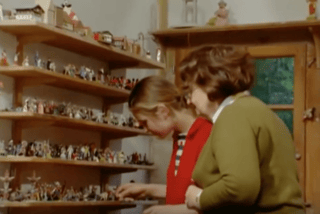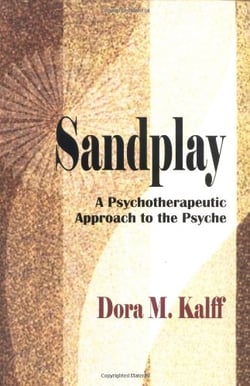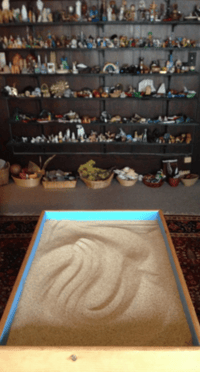Sandplay as a Healing Modality; An Interview with Jungian Analyst and Professor, Jorge de la O A. Guest Post by Bonnie Bright, Ph.D.
 For Jungian analyst and professor, Jorge de la O, the desire to become a therapist began in the late 1970s when he saw Violet Oaklander,[1] who was instrumental in her work with children and adolescents using Gestalt therapy, at a confluent education conference at USC. Oaklander presented some slides on the process of sandtray (a somewhat different process from Sandplay, the Jungian approach to sandtray which was created by Jungian analyst Dora Kalff)[2]. When Jorge saw the trays and the work Oaklander was doing, he was completely taken by it. "It was magical," he reports. As a kindergarten teacher at the time, he knew he wanted Sandplay in his life, and a seed was planted.
For Jungian analyst and professor, Jorge de la O, the desire to become a therapist began in the late 1970s when he saw Violet Oaklander,[1] who was instrumental in her work with children and adolescents using Gestalt therapy, at a confluent education conference at USC. Oaklander presented some slides on the process of sandtray (a somewhat different process from Sandplay, the Jungian approach to sandtray which was created by Jungian analyst Dora Kalff)[2]. When Jorge saw the trays and the work Oaklander was doing, he was completely taken by it. "It was magical," he reports. As a kindergarten teacher at the time, he knew he wanted Sandplay in his life, and a seed was planted.
After teaching children in Valencia, Spain, Jorge came back to the United States taking a position as an elementary school teacher. What he experienced in this transition was a culture shock. In many schools, “children have their soul taken from them…in the name of profit,” Jorge asserts, remembering how disturbing it was to see children in the U.S. become consumers of popular culture. Jorge was rattled when he witnessed how the mostly Chicano or Mexican children he was teaching tend to “become what is expected of them by society through projective identification,” which results in a general disconnect from relationships.
In the throes of this distressing realization, Jorge realized it was time to go back and become a therapist so he would be equipped to meet the part of the students’ psyche in a way that is rather difficult to do in public schools due to curriculum and requirements for the teachers.
Ultimately, therapy is about the therapist’s relationship to the client, which is also true in the classroom, where teachers have a relationship with the students, he points out. Yet, in the classroom, there's often no room to develop the kind of relationship that’s needed so kids could tap more into their essential selves. As a teacher, himself, Jorge used artwork in the classroom to help enable that process, but he readily acknowledges that it's not the same thing as being in a clinical setting. That realization is what motivated him to choose Pacifica Graduate Institute and enroll in the M.A. Counseling Psychology Program there.
After starting the program at Pacifica, Jorge’s early fascination with Sandplay was renewed. The Counseling program required that each student training to be a therapist undergo their own personal therapy, so Jorge immediately looked for a Sandplay therapist who was also a Jungian analyst. All the tumblers just sort of fell into place right from the beginning, he notes.
 I can relate to Jorge’s perception of Sandplay as “magical,” having been completely taken by some of the case studies presented at a recent conference I attended on Sandplay, and how Sandplay works so magnificently in the healing process. The founder of Sandplay (and author of the book by the same name), Dora Kalff, saw Sandplay as a free and open space where individuals create images in the sand using miniatures[3], Jorge informs me. It is a nonverbal form of therapy which allows psyche to come to the surface, much like active imagination. Part of the magic, as Jorge explains it, seems related to how he imagines artists and poets experience their creations of art and poetry. As a psychoanalyst, he finds himself continually amazed at what comes up through the sand, which engages deep layers of the unconscious.
I can relate to Jorge’s perception of Sandplay as “magical,” having been completely taken by some of the case studies presented at a recent conference I attended on Sandplay, and how Sandplay works so magnificently in the healing process. The founder of Sandplay (and author of the book by the same name), Dora Kalff, saw Sandplay as a free and open space where individuals create images in the sand using miniatures[3], Jorge informs me. It is a nonverbal form of therapy which allows psyche to come to the surface, much like active imagination. Part of the magic, as Jorge explains it, seems related to how he imagines artists and poets experience their creations of art and poetry. As a psychoanalyst, he finds himself continually amazed at what comes up through the sand, which engages deep layers of the unconscious.
Sandplay trays are always rectangular and have a specific depth, with the base and sides painted blue in color to represent water when the sand is pushed aside. The miniatures used in the tray consist of hundreds or even thousands of virtually every kind of figure imaginable that might be used to create an image, scene, or story—including things like nature objects, toy soldiers, animals, mythical figures, indigenous objects, vehicles, tools, cultural icons, and objects with spiritual or religious connotations. Jorge has been collecting Sandplay miniatures since the '90s, around the time he started at Pacifica.
 Clients also typically have access to real water as they work, and can choose to work in a dry tray with dry sand, or in a wet tray where they can add water and actually sculpt the sand. The possibilities are endless, Jorge insists, noting that as a therapist witnessing the creation of a sand tray, there is a point where the ego gives way to psyche, which is present in the room and leads the way in the creation of the trays. In that process, healing occurs.
Clients also typically have access to real water as they work, and can choose to work in a dry tray with dry sand, or in a wet tray where they can add water and actually sculpt the sand. The possibilities are endless, Jorge insists, noting that as a therapist witnessing the creation of a sand tray, there is a point where the ego gives way to psyche, which is present in the room and leads the way in the creation of the trays. In that process, healing occurs.
In my own limited experience with Sandplay, I perceive that what occurs in the process of Sandplay feels similar to what happens in dreams, through which images and symbols emerge that may enable us to gain some new understanding.
Over a series of trays, scenes do seem to emerge, much like in dreams, Jorge reports. When certain objects appear again and again, it's like a trail. You can follow certain objects as they are placed and used in a tray repeatedly. However, even though a Sandplay therapist may observe that certain symbols might possibly represent certain things (for example, a tree might represent the self), Jorge himself always likes to “leave room for the mystery of that tray in that moment of creation,” and not limit it by making too many judgments or assumptions.
After completing his Counseling degree at Pacifica, Jorge first chose to pursue training as a Jungian analyst, and then becoming a registered Sandplay therapist through AST (Association for Sandplay Therapy). His decision to become a Jungian analyst was founded in part on a desire to deepen his connection to psyche. More importantly, however, as a person of color, as a Chicano seeking to become a Jungian analyst, Jorge saw that Jung and Jungian psychology, or analytical psychology, was the only place that “allowed [his] gods to exist”; the only way that honored his psyche, or his gods, because it “made room for them.”
Jorge goes on to share other influences on his therapeutic philosophy, including the work of Carl Rogers and his idea of the core conditions particularly, including: respect for the client, unconditional positive regard, and empathy, among them. In addition to teaching, he also does supervision for candidates in training, as well as MFTs who are on the road to licensure, and stresses these core conditions as a foundation for their training.
Jorge is profoundly committed to the exploration of what empathy means and talks to the candidates and interns about those core conditions. In many ways as therapists, that's what we're doing, he notes; “It takes us right back to relationship. Again, it's the relationship that heals.” He references Jung, who commented that in the “cauldron”—the mix or stew—both the analyst and the analysand are impacted by the work.
Jorge, who teaches “The Art of Listening” among his many other courses at Pacifica, admits he also loves teaching analytical psychology because he’s passionate about Jung and the process of psychotherapy. His work includes helping students understand their own triggers, where they get activated, and how to listen to their partners or clients better, as well as how to listen to themselves. He also teaches multicultural counseling (defined quite simply by the Psychology Dictionary as “taking into consideration a client’s cultural beliefs and the effect that can have on their treatment”[4]), a practice which Jorge hopes will create ripples for a more just society and country. Jorge has recently published a chapter in a book targeting supervisors in psychotherapy, which discusses how to bring multicultural psychotherapy into supervision.
 As for other current projects, Jorge has teamed up with Abner Flores, a recent graduate from Pacifica, and together they are working on the concept of La Chingada, which is best translated as “the violation,” according to Jorge. La Chingada began in 1492 and pertains to the violation that has occurred for over 500 years since Europeans first arrived in the Americas, Jorge explains. In their presentation on the topic, Jorge and Abner offer up images of the conquest, and explore how La Chingada impacts not only the psyche of people of color, but of white people as well. Many of the concepts and images they are using have connections to pre-Colombian identity and focus on La Chingada as an image of empowerment through understanding oppression. The pair are presenting their work, “Los Hijos de la Chingada and the Trauma of the Cultural Complex” at the C. G. Jung Club of Orange County on October 1, 2017.
As for other current projects, Jorge has teamed up with Abner Flores, a recent graduate from Pacifica, and together they are working on the concept of La Chingada, which is best translated as “the violation,” according to Jorge. La Chingada began in 1492 and pertains to the violation that has occurred for over 500 years since Europeans first arrived in the Americas, Jorge explains. In their presentation on the topic, Jorge and Abner offer up images of the conquest, and explore how La Chingada impacts not only the psyche of people of color, but of white people as well. Many of the concepts and images they are using have connections to pre-Colombian identity and focus on La Chingada as an image of empowerment through understanding oppression. The pair are presenting their work, “Los Hijos de la Chingada and the Trauma of the Cultural Complex” at the C. G. Jung Club of Orange County on October 1, 2017.
Some Jungians are looking at the issue from the perspective of the cultural complex or in terms of the cultural psyche as a layer of the psyche, Jorge points out. Jungians, as well as others, are beginning to understand and work with the impact of imperialism and of colonization worldwide. Whether it's slavery in the United States, the conquest of Mexico and Latin America, colonization in Hawaii, or genocide anywhere in the world, each instance is related to conquest. The trauma resulting from this conquest continues to live in the psyche of people of color, but it has also created an imbalance for Europeans and white people as well.
This, as I know from my own experience, is an arena where Pacifica Graduate Institute excels, by bringing this type of conversation to the foreground with the inclusion of liberation psychologies in many of the programs. I sense that through the meaningful work of Jorge and many others at Pacifica and elsewhere, the topic of conquest and colonialism is becoming more of a cultural phenomenon which we can begin to look at, hold, and even engage some of those same issues that are currently drawing Jorge’s attention to a tremendous extent. And, through his own unique combination of gifts and experience, and the archetypal energies he carries as a teacher and healer, Jorge is clearly making a profound contribution to Pacifica and to the greater depth psychology community as well.
Listen to the full audio interview with Jorge de la O here: (approx. 30 minutes)
Learn more about the Master’s in Counseling program at Pacifica- https://www.pacifica.edu/
[1] Learn more about Violet Oaklander at the Violet Solomon Oaklander Foundation at http://www.vsof.org/foundingmembers.html
[2] Read an informative article, “What is Sandplay?” published in the Journal of Sandplay Therapy by Kay Bradway, Volume 15, Number 2, 2006
[3] Read an article by Kalff, “Introduction to Sandplay Therapy,"
[4] Retrieved from https://psychologydictionary.org/multicultural-counseling/
 Jorge de la O is a professor in the M.A. Counseling Psychology Program at Pacifica where he has taught The Art of Listening, Process of Psychotherapy, Law and Ethics, Multicultural Counseling Theories and Technique, Group Process, Clinical Practice and has served as a Portfolio Evaluator for the Thesis. He serves as Core Professor and is an IAAP certified Jungian Analyst and Registered Sandplay Therapist with a private practice in Ventura, California. In 2010, Jorge retired as a schoolteacher after 36 years in public and private education in the United States and in Spain. Jorge has taught all grades from pre-school through the 8th grade. He has been honored with numerous awards for his excellence in education. In 2011, Jorge was awarded the Distinguished Service Award from Pacifica Graduate Institute. Jorge is also a poet and has published in “Psychological Perspectives”, Issues 42 and 49. In addition to teaching at Pacifica, Jorge is a registered Sandplay therapist and presented his certification paper entitled, “The Frozen Feminine: A Control Case” at the C.G. Jung Study Center of Southern California. Jorge enjoys hiking in the Upper Ojai and spending time along the Ventura/Santa Barbara coast with his wife and their Portuguese water dogs, Meara and Reilly.
Jorge de la O is a professor in the M.A. Counseling Psychology Program at Pacifica where he has taught The Art of Listening, Process of Psychotherapy, Law and Ethics, Multicultural Counseling Theories and Technique, Group Process, Clinical Practice and has served as a Portfolio Evaluator for the Thesis. He serves as Core Professor and is an IAAP certified Jungian Analyst and Registered Sandplay Therapist with a private practice in Ventura, California. In 2010, Jorge retired as a schoolteacher after 36 years in public and private education in the United States and in Spain. Jorge has taught all grades from pre-school through the 8th grade. He has been honored with numerous awards for his excellence in education. In 2011, Jorge was awarded the Distinguished Service Award from Pacifica Graduate Institute. Jorge is also a poet and has published in “Psychological Perspectives”, Issues 42 and 49. In addition to teaching at Pacifica, Jorge is a registered Sandplay therapist and presented his certification paper entitled, “The Frozen Feminine: A Control Case” at the C.G. Jung Study Center of Southern California. Jorge enjoys hiking in the Upper Ojai and spending time along the Ventura/Santa Barbara coast with his wife and their Portuguese water dogs, Meara and Reilly.
 Bonnie Bright, Ph.D., is a graduate of Pacifica’s Depth Psychology program, and the founder of Depth Psychology Alliance, a free online community for everyone interested in depth psychologies. She also founded DepthList.com, a free-to-search database of Jungian and depth psychology-oriented practitioners, and she is the creator and executive editor of Depth Insights, a semi-annual scholarly journal. Bonnie regularly produces audio and video interviews on depth psychological topics. She has completed 2-year certifications in Archetypal Pattern Analysis via the Assisi Institute and in Technologies of the Sacred with West African elder Malidoma Somé, and she has trained extensively in Holotropic Breathwork™ and the Enneagram.
Bonnie Bright, Ph.D., is a graduate of Pacifica’s Depth Psychology program, and the founder of Depth Psychology Alliance, a free online community for everyone interested in depth psychologies. She also founded DepthList.com, a free-to-search database of Jungian and depth psychology-oriented practitioners, and she is the creator and executive editor of Depth Insights, a semi-annual scholarly journal. Bonnie regularly produces audio and video interviews on depth psychological topics. She has completed 2-year certifications in Archetypal Pattern Analysis via the Assisi Institute and in Technologies of the Sacred with West African elder Malidoma Somé, and she has trained extensively in Holotropic Breathwork™ and the Enneagram.



